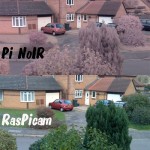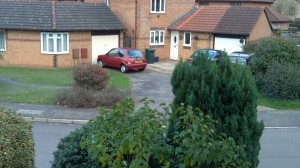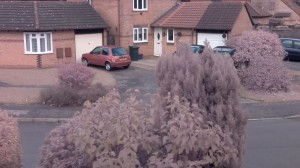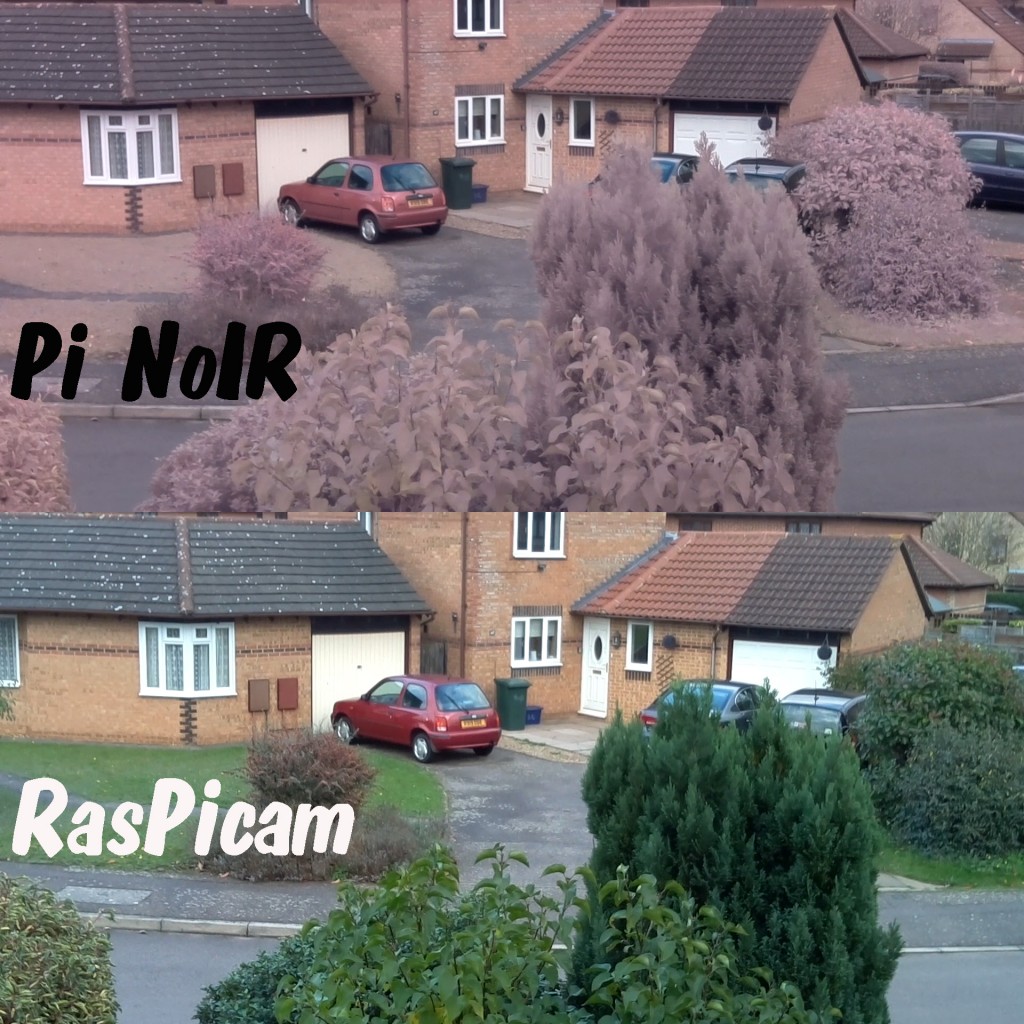
The PiNoIR Raspberry Pi camera without infra-red filter is about to hit the streets. It looks like the first purchased units have shipped already. Matt “Raspberry Pi Spy” Hawkins has got one he bought from RS. I’m not quite sure what happened there, since the product isn’t officially launched yet. But no doubt others will have them soon enough.
Needless to say, before it even officially hits the streets, people are arguing about what it is, what it isn’t and how the Raspberry Pi Foundation should and shouldn’t be referring to it. (What a pedantic, picky bunch we computer types are!)
In her original announcement about the Pi NoIR camera module, Liz Upton wrote…
“Sunny, who make the sensor, filter and lens package that’s at the heart of our camera board, did not offer a package without the filter at all. Removing it would mean an extra production line would have to be set up just for us – and they had other worries when we started to talk to them about adding an infrared camera option. They told us they were particularly concerned that users would try to use a camera board without a filter for regular daytime photography, and be would be upset at the image quality.“
It’s not for regular daylight photography
To show you why, here’s two screen shots from a comparison video I shot yesterday with both original RasPiCam and Pi NoIR simultaneously…
I made them small so you can compare them side by side. Click either shot to enlarge to full 1920×1080 size. It was a dull, cloudy day. There’s a larger version below…
Here’s what Pi NoIR IS for
- camera effects e.g. black and white IR photos
- low-light photography with IR lighting
- wildlife photography (nocturnal with IR lighting)
- specialist archaeological applications
- specialist botanical applications
And of course, a lot of us will get one to experiment with. I have in mind a project involving either a servo or solenoid and a light sensor to control the position of an IR cut filter for a 24-hour surveillance camera.
I hope this helps you decide whether the PiNoIR is for you or not. I haven’t yet sorted out an IR source, so can’t show anything useful as regards night-time shots.



Excellent comparison – I think that I might order one! And what is this illumination stuff? I have to have an IR led as well?
The Raspberry Pi Guy
Several IR leds actually Matt. Most IP cam security cams have the lens unit pretty much surrounded by IR leds, although I haven’t yet researched what wavelength, angle etc.
now if someone makes a model ‘C’ RPI with 2 camera inputs, one for regular and one for noir version.
I don’t think the GPU would cope with 2 at once.
Actually, the BCM2835 does have two CSI interfaces on it http://elinux.org/RPi_BCM2835_Pinout but only one of them is exposed to the outside world on the RaspberryPi board (the second interface is inaccessible under the BGA). But presumably if you were to connect two cameras at once to some other theoretical BCM2835-based board then you wouldn’t be able to run them both at the maximum resolution/framerate at the same time.
Alex – just to reinforce the above “what’s it for” article, it might be worth including comparison shots of an IR-illuminated scene taken at night with both cameras too? :-)
It will be done when the IR source arrives :)
IIRC in one of the very early IR-with-PiCam photos (i.e. where they were removing the filter manually with a knife and great care) they were just using a TV remote-control as an IR source? I’m sure you must have one or two of those ;)
I don’t remember the photos, but I’m after something with a useful range (5-10m). Should have some fairly “bright” 850nm leds arriving tomorrow.
John and I did test this camera module with a TV remote pointing straight at it on Friday at RPi HQ. It showed up, but didn’t have a lot of oomph (perhaps because of pulsing?)
850nm LEDs? Make sure you have your magnifying glass handy before opening the envelope ;-D
That made me laugh out loud :-)
The compute module has 2 dsi and 2 camera ports
How hard would it be to write a driver for the kernel and path it? There are two connectors, so there must have been plans to use the second port. Otherwise, why would they spend the extra $ ?
If some one has the expertise to do it, I am sure he will make enough money to make it worthwhile.
Just an idea…
The second port is a DSI port for a display.
In that case, what a **** design!
[…] Read more here […]
Idea of a relay and IR fiter’s what I’m going for. Plus a shedload of IR LED’s . Project to be housed in a large dummy outdoor CCTV case (Ideal! Weatherproof, and loadsa battery space!) I’d be interested to sear the results of the filterless camera with an IR filter, if anyone’s done it yet. Would any light ‘bleed’ around the filter affect it, and what would be the spec?
Can’t find the spec. of the original filter unfortunately.
Quick squint on ebay suggests about a fiver gets TWO “9.5mm Optical UV-IR CUT filter” – “..”two, in case you break the first trimming it to shape”) and a cheap servo about the same. Suck-it-and-see, I guess
Question, is it possible to put a filter in front of the PiNoIR camera to get the best of both worlds? As in, during the day a glass filter is placed in front of the camera, and then at night the filter is removed and IR is turned on to see better at night?
It should be, yes. Not got one yet though.
[…] at RasPiTV shows how his new Pi NoIR stacks up against his RasPicam for daylight photography and draws some […]
Would be nice to compare results of both cameras at the focus of a telescope on astronomical subjects… I was planning to take the filter off of a spare PiCam but this one is better – no risks!
I have yet to try the camera that we received recently. Just a quick question – is it possible to take long exposures on these ?
Thanks
Shashi
—
I belive it is but I haven’t tried it.
[…] – https://raspi.tv/2013/pinoir-whats-it-for-comparison-of-raspicam-and-pi-noir-output-in-daylight […]
Hi,
So what would be the best camera to use as part of a simple security camera?
For both day and nighttime footage.
Thanks!
The PiNoIR with an infra-red source
Hello, I just want to know if it’s possible to add an IR filter in front of the NoIR camera and have the same picture of the normal camera?
The NoIR camera comes with an IR filter so you can do exactly that.
The filter that comes with the NoIR camera isn’t an IR filter… https://www.raspberrypi.org/blog/whats-that-blue-thing-doing-here/
Ooohhh…the description on Amazon is wrong then! It says:
“[a] small piece of blue filter plastic is included in case you want to re-add the cut filter,”
…but now you mention it – why would an “IR cut filter” be blue?! I should have thought of that.
My apologies – I was severely ill-informed by Amazon!
I’m trying to use the regular Pi camera to view the output from a rather dim projection TV system (this is a kind of robotics application…it’s complicated!) – the results are great for green and blue, but at low light levels, I’m not seeing any of the red light from the projector showing up in the camera.
There is no IR light coming from the projector (I hope!) but I wonder whether the IR filter in the regular camera is reducing the sensitivity to red light too?
Your daylight pictures look very pink in the PiNoIR camera – but I’m assuming that’s just the IR light being seen as red – rather than extra sensitivity to red. Certainly the red car in the photo doesn’t look brighter in the PiNoIR than in the regular camera.
I’ve just ordered the PiNoIR to give it a try – but I’d be interested in any comments you might have.
does the program code used the same on raspberry pi?
Yes. The only (hardware) difference between the regular and pinoir camera is that the pinoir camera lacks the IR filter. From a software point of view they’re identical.
Hello, little late to the game. My husband is wanting to build one of these. I am
A photographer, and I know that with regular IR photography, images don’t come out the way your image shows. Will we need a special program to see the images?
With the NoIR camera, the images are produced exactly as shown. You will not need any different software. :)
If you wanted these to look more like a ‘traditional’ IR image, I guess you could use some image-processing software to strip out the Green and Blue channels, and then convert the Red channel to grayscale? But note that this will still show “Red + InfraRed” and not “just InfraRed” that you might be used to with “regular IR photography”.
Unless you used some kind of additional filter in front of the NoIR camera that _only_ allowed through InfraRed light? (I’m just guessing here, I’m not a photographer myself!)
Can someone upload a picture of the sky (including the sun and clouds) with a NoIR camera?, Thanks in advance for your help.